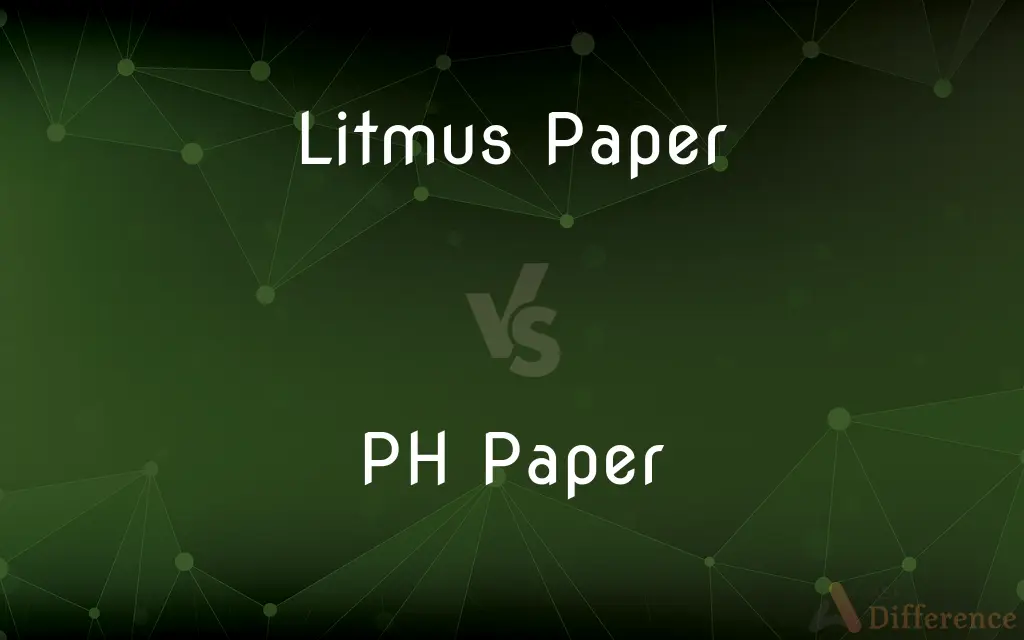Litmus Paper vs. PH Paper — What's the Difference?
By Tayyaba Rehman — Published on October 24, 2023
Litmus Paper indicates if a solution is acidic or basic, turning red or blue, respectively. PH Paper provides a specific pH value, showing a color spectrum from acidic to basic.

Difference Between Litmus Paper and PH Paper
Table of Contents
ADVERTISEMENT
Key Differences
Litmus Paper: Derived from lichens, Litmus Paper is a simple tool that determines whether a solution is an acid or a base. When a substance is acidic, Litmus Paper turns red. Conversely, basic (or alkaline) substances turn the paper blue. PH Paper, on the other hand, offers a more comprehensive and quantitative measurement of a solution's pH.
PH Paper: Unlike Litmus Paper which generally offers binary results (acidic or basic), PH Paper can provide a specific pH value of a solution. This is done by matching the color that the paper turns to a pH color scale. This allows for a more nuanced understanding of a solution's acidity or alkalinity compared to the straightforward results given by Litmus Paper.
Range and Usage: Litmus Paper has a narrower focus, primarily distinguishing between acids and bases. PH Paper, however, covers the entire pH scale from 0 to 14, thus providing a specific pH reading. While both can be used in labs and for educational purposes, PH Paper's detailed results make it preferable in precise scientific applications.
Accuracy: Although Litmus Paper can quickly identify the general nature of a solution, its results are qualitative. In contrast, PH Paper offers a quantitative measurement, enabling more accuracy and specificity in determining the pH of a solution.
Application in Everyday Life: Both Litmus Paper and PH Paper find uses outside professional labs. For instance, gardeners might use Litmus Paper to check soil acidity, while aquarium enthusiasts might employ PH Paper to ensure optimal water conditions for their fish.
ADVERTISEMENT
Comparison Chart
Primary Usage
Indicates if a solution is acidic or basic.
Provides specific pH value of a solution.
Result Type
Qualitative (acidic or basic)
Quantitative (specific pH number)
Color Change
Turns red for acids, blue for bases.
Changes to various colors across pH spectrum.
Range
Primarily distinguishes acids from bases.
Covers the entire pH scale (0-14).
Derived From
Lichens
Chemically treated paper.
Compare with Definitions
Litmus Paper
Paper that turns red in acidic solutions and blue in basic ones.
When testing the liquid, the Litmus Paper turned blue, indicating it was basic.
PH Paper
Covers the entire range of the pH scale.
With PH Paper, she could identify anything from a strong acid to a strong base.
Litmus Paper
Derived from lichen-based indicators.
Historically, Litmus Paper's color-changing properties are due to natural dyes from lichens.
PH Paper
Essential for detailed scientific and industrial applications.
The brewery utilized PH Paper to ensure the right acidic conditions for fermenting beer.
Litmus Paper
A common tool in basic chemistry experiments.
In the classroom, children used Litmus Paper to test various household liquids.
PH Paper
Indicates acidity or alkalinity based on a color spectrum.
The PH Paper turned a shade of green, corresponding to a neutral pH level.
Litmus Paper
A tool that identifies acidic or basic properties.
She dipped the Litmus Paper into the solution to see if it was acidic.
PH Paper
A tool providing specific pH measurements.
By using PH Paper, he was able to determine the exact pH of the rainwater.
Litmus Paper
A qualitative means to test for pH.
Using Litmus Paper, the students quickly determined the general pH of their samples.
PH Paper
A quantitative method for assessing pH values.
For her science project, she employed PH Paper to test the acidity of different fruit juices.
Common Curiosities
How does PH Paper show the pH value?
PH Paper changes color when dipped into a solution, and this color is matched to a pH scale to determine the exact pH value.
Can PH Paper determine if a solution is weakly or strongly acidic?
Yes, PH Paper provides specific pH values, allowing differentiation between weak and strong acids.
Are Litmus Paper results quantitative or qualitative?
Litmus Paper provides qualitative results, indicating if a solution is acidic or basic.
What's the primary use of Litmus Paper?
Litmus Paper is used to determine if a solution is acidic (turns red) or basic (turns blue).
What's the origin of Litmus Paper's color-changing ability?
Litmus Paper is made from natural dyes derived from lichens.
In what scenarios is PH Paper preferable over Litmus Paper?
PH Paper is preferable when a specific pH reading or more detailed analysis of a solution's acidity or alkalinity is needed.
Why might someone use Litmus Paper over PH Paper?
Litmus Paper is simpler to use and is suitable for basic experiments where only a general indication of acidity or basicity is needed.
Can I use PH Paper to test the pH of my pool?
Yes, PH Paper can be used to test the pH of pool water to ensure it's safe and comfortable for swimmers.
Is it possible to get a pH reading of 7.5 using Litmus Paper?
No, Litmus Paper gives general results (acidic or basic). For specific pH readings like 7.5, PH Paper is required.
How do I store Litmus and PH Paper?
Both should be stored in a cool, dry place away from direct sunlight and moisture.
Can Litmus Paper detect neutral solutions?
Litmus Paper primarily indicates if a solution is acidic or basic, not its neutrality.
How broad is the pH range that PH Paper can detect?
PH Paper typically covers the entire pH range, from 0 (strongly acidic) to 14 (strongly alkaline).
Are there any safety precautions when using Litmus or PH Paper?
Both papers are generally safe. However, after testing, it's a good practice to avoid touching the test area and to wash hands after handling chemicals.
Which is more accurate for scientific experiments: Litmus or PH Paper?
PH Paper is more accurate as it provides specific pH values.
Are there digital alternatives to PH Paper?
Yes, pH meters are digital devices that provide precise pH readings.
Share Your Discovery

Previous Comparison
Oxybenzone vs. Avobenzone
Next Comparison
Skewness vs. KurtosisAuthor Spotlight
Written by
Tayyaba RehmanTayyaba Rehman is a distinguished writer, currently serving as a primary contributor to askdifference.com. As a researcher in semantics and etymology, Tayyaba's passion for the complexity of languages and their distinctions has found a perfect home on the platform. Tayyaba delves into the intricacies of language, distinguishing between commonly confused words and phrases, thereby providing clarity for readers worldwide.













































